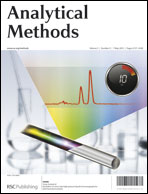A simple, rapid and visual antibody array for the simultaneous detection of multiple plant pathogens†
Abstract
Most traditional methods for pathogen detection, such as the ELISA and PCR, can only detect a single target pathogen at any one time. Here, an antibody array assay system has been developed to detect multiple pathogens in plants at the same time. The system provides a rapid, visual and cheap strategy that combines the pore plate integrated antibody array with a classical double antibody sandwich method. After incubating the array with samples, reaction signals are amplified by specific detection antibodies linked with alkaline phosphatase. All the assays can be completed within 6 hours. Furthermore, the results can be directly examined by the naked eye or by scanning with a flat bet scanner for quantitative analysis. With almost the same sensitivity as the ELISA, the array can detect 10 pathogens in one well simultaneously. This array system is used to screen 24 seed samples (240 detection items in all) and shows a high consistency (240/240) with results from the ELISA, indicating that this antibody array assay system could be used as a rapid method to simultaneously analyse at least ten pathogens, not only for lab research but also for practical applications.


 Please wait while we load your content...
Please wait while we load your content...